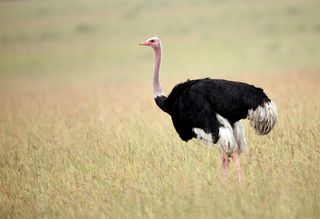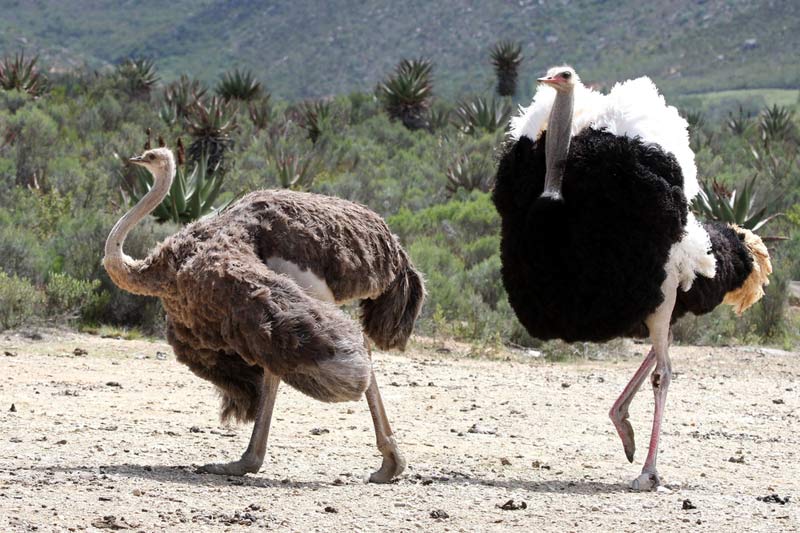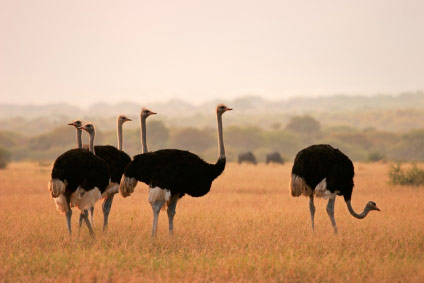What Does the Cry of an Ostrich Sound Like in the Swiss Family Robinson
Ostrich Facts: The Globe'due south Largest Bird

Ostriches are large, flightless birds that have long legs and a long neck that protrudes from a circular torso. Males accept bold blackness-and-white coloring that they use to attract females. Females, on the other mitt, are calorie-free brown.
Ostriches are bigger than any other bird in the earth. They can grow up to 9 feet (2.7 meters) tall and can weigh up to 320 lbs. (145 kilograms), according to the African Wild fauna Foundation, and an ostrich's eyes are 2 inches (5 centimeters) in diameter — the largest of whatsoever land animal. The ostrich is the only bird that has ii toes on each foot. All other birds take three or 4 toes, co-ordinate to the American Ostrich Association.
Where do ostriches live?
Wild ostriches live in the dry, hot savannas and woodlands of Africa. They one time roamed all over Asia, Africa and the Arabian Peninsula, but considering they take been hunted so extensively, wild ostriches' range has been reduced to sub-Saharan Africa, according to the University of Michigan Museum of Zoology. However, ostriches can be found in captivity all over the world.
What practice ostriches swallow?
Ostriches are omnivores, which means they eat both vegetation and meat. Although they prefer plants — especially roots, seeds and leaves — they also eat locusts, lizards, snakes and rodents, according to the San Diego Zoo. They besides eat sand and pebbles, to help grind upward their food inside their gizzard, which is a pocket-size pouch where food is crushed and ripped up earlier it reaches the stomach.
Ostriches don't need to potable water; they get all the water they need from the plants they eat. However, they do potable if they come up across a watering pigsty.

Mating habits
Male ostriches are called cocks or roosters, and females are chosen hens. A grouping of ostriches is called a flock. Flocks can consist of upwardly to 100 birds, though most have 10 members, according to the San Diego Zoo. The grouping has a dominant male and a dominant female and several other females. Lone males come and go during mating flavor.
To become a female person'southward attention, males bow and flap their wings outward to brandish their plume. When they are ready to mate, the male's nib and shins volition turn bright red. Sometimes, his cervix will change to a scarlet colour to match. Females also alter color when they are ready to mate. Their feathers volition turn a silvery color, according to the American Ostrich Association.
Ostrich eggs & baby ostriches
Ostrich eggs are half dozen inches (15 cm) in diameter and can weigh upward to 3 lbs. (1.iii kg). Eggs are laid in a communal nest chosen a dump nest, which can agree about 60 eggs at one time. Males, too every bit females, sit down on the eggs until they hatch, which can take 42 to 46 days.
Ostrich offspring are larger than any other bird infant. At nascency, chicks can exist as big as chickens. The males and females share the responsibleness of taking intendance of the immature, according to the San Diego Zoo. During an attack, the male tries to lure the predator away from the chicks while they run for cover with the female.
By vi months, a chick is well-nigh at its full-grown meridian; at 3 or four years, it will attain maturity. An ostrich tin can alive 50 to 75 years.

Classification/Taxonomy
Ostriches are in the same order as cassowaries, emus, kiwis and rheas. The taxonomy of ostriches, co-ordinate to the Integrated Taxonomy Information Arrangement (ITIS), is:
- Kingdom: Animalia
- Phylum: Chordata
- Class: Aves
- Order: Struthioniformes
- Family: Struthionidae
- Genus & species: Struthio camelus
- Subspecies: Struthio camelus camelus (red-necked or N African ostrich), Struthio camelus molybdophanes (Somali ostrich), Struthio camelus massaicus (Masai ostrich), Struthio camelus australis (South African or Southern ostrich)
Conservation status
According to the International Spousal relationship for Conservation of Nature'southward (IUCN) Ruby List, most ostrich subspecies are not endangered, though their populations are failing. The Somali ostrich is listed as vulnerable, though their population is unknown. It is believed that they are on a rapid decline.
Other facts
It may seem amazing that an ostrich's sparse legs can keep their large bodies upright. Their legs are perfectly placed so that the torso's center of gravity balances on top of its legs.
Their thin legs give them dandy speed and maneuverability, as well. They can run upward to 40 mph (64.3 km/h) for sustained periods of time, according to the American Ostrich Clan.
Contrary to popular belief, ostriches don't bury their heads in the sand, but they practice prevarication down with their heads against the ground when they experience threatened. It simply looks like the ostrich has buried its head because its caput and cervix blend in with the color of the sand.
Ostriches fight with their feet. They boot forward because that's the direction in which their legs bend, co-ordinate to the American Ostrich Clan. A solid kick tin can impale a lion.
Ostrich feathers look shaggy considering they hang loosely and don't hook together like feathers on other types of birds.
Boosted resources
- IUCN Red List: Ostrich
- PBS Nature Critter Guide: Ostriches
- African Wildlife Foundation: Ostrich
Source: https://www.livescience.com/27433-ostriches.html

0 Response to "What Does the Cry of an Ostrich Sound Like in the Swiss Family Robinson"
Postar um comentário